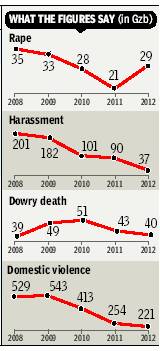Ghaziabad
This is a collection of articles archived for the excellence of their content. Readers will be able to edit existing articles and post new articles directly |
Contents |
Cleanliness
2018: Rapid, 315- rank rise on cleanliness ladder
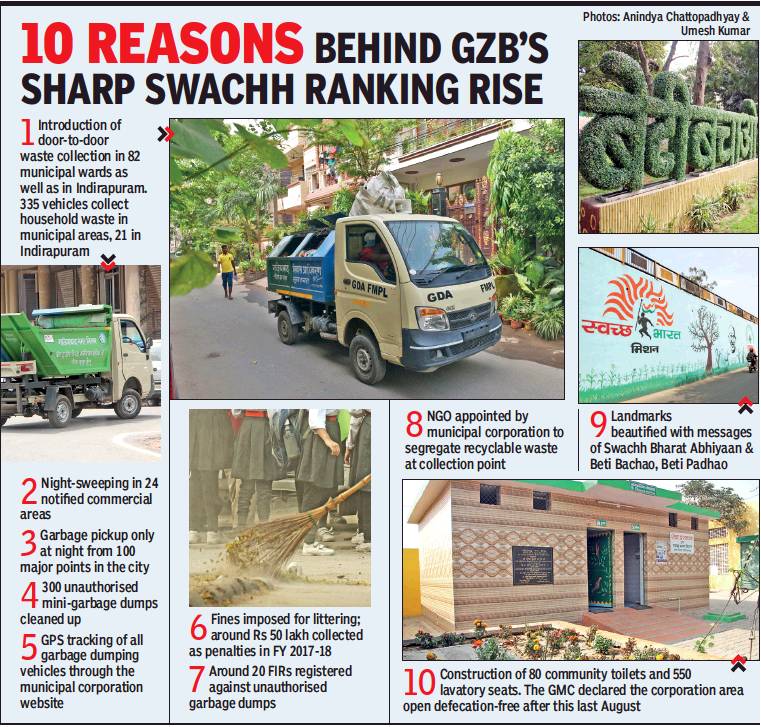
From: Abhijay Jha, Aditya Dev & Ayaskant Das, Gzb up 315 places on cleanliness ladder, but work far from over, May 18, 2018: The Times of India
A coordinated effort by several government agencies, spearheaded by Ghaziabad Municipal Corporation (GMC), has resulted in Ghaziabad being named the fastest moving big city in Swachh Survekshan 2018, results of which were declared by the Union housing and urban affairs ministry.
Ghaziabad moved up to rank 36 from 351 in 2017, in the pan-India exercise conducted by the central government across 4,203 cities to assess cleanliness in urban areas. A year before, in 2016, the city was ranked 67 among 73 cities, till thousands more cities were included under the survey in 2017, pushing its rank further down.
A lot remains to be done, though, as proximity to the national capital means the city should strive to benchmark itself with the leaders. But the task might get more difficult in the coming years, as it is easier to move up the ranks when you start from a low base, than when competing with the best.
According to GMC, a number of initiatives undertaken over the past year, has resulted in this quantum leap. These include introduction of door-to-door garbage collection using 335 vehicles with GPS tracking in 82 wards since June 2017, construction of 100 community toilets with 417 seats across the city, and renovation of existing toilets.
In 2017, the civic body had also introduced night-sweeping in 24 areas to reduce pollution, and to pick up garbage from 100 points. Over 300 unauthorised garbage dumps were sanitized and the areas cordoned off for beautification. The civic body also imposed massive fines for littering, and collected around Rs 50 lakh in penalties.
The city generates around 850 metric tonnes of solid waste daily, of which, 200 tonnes is sent to a waste-to-energy plant in neighbouring Pilkhuwa for conversion into electricity, while around 100 tonnes is used for composting in around 250 parks in the city.
The Pratap Vihar dumping ground receives 300 tonnes of waste, some of which is sent to a waste-to-compost plant in Kavi Nagar.
“We’ve roped in an NGO, Chintan, whose staff segregate recyclable material at source. This reduces the total amount of solid waste at the disposal point. Night-sweeping has been outsourced to private firms. Around 100 points have been earmarked in busy areas, including Vaishali, Raj Nagar District Centre, Kavi Nagar, Vasundhara and near Kaushambi metro station, from where garbage is picked up by vans,” municipal commissioner Chandra Prakash Singh told TOI.
Six automatic sweeping machines were also deployed across the city. GMC has also employed online measures like the Swachhata App to register complaints. “There was manpower crunch, but we roped in government employees from even other departments. The next challenge is to ensure the system works without rigorous supervision, and to extend the services to the remaining 18 wards,” said Singh.
GDA intends to take the mission further by making Indirapuram housing societies adopt a solid waste management model in high-rise housing societies. GDA is already in talks with Federation of Apartment Owners’ Association (FedAOA) to rope in the societies for the purpose, so that some composting and segregation happens at source.
Several good practices of other civic bodies are being implemented, such as construction of five solid waste sorting-cum-transfer stations in the district in the first phase, and 10 in total. “Once functional, solid waste will be brought here for segregation and compression, then transferred to the landfill site, to reduce costs involved in their transfer. Around Rs 90 lakh will be spent on constructing one such transfer station,” Singh added.
Crime in Ghaziabad
Gzb shamed: Crimes against women rise
Rape, Molestation Cases Almost Routine
TIMES NEWS NETWORK
The Times of India 2013/07/27
Ghaziabad: Acid attacks in Ghaziabad sadly represent only a fraction of the crimes against women. Rapes, molestation and harassment have almost become routine. Even though police say they’re doing their best to prevent such incidents, the frequency of crimes against women speaks for themselves.
According to senior cops, a rape takes place every week in the city and many go unreported. While cases of ‘molestation’ are common, chain snatchers exclusively target women. “The situation is so bad that one fears getting out of the house after it gets dark. The police is barely helpful, and in some cases, they are at fault,” said Renu Sharma, a Delhi University student who lives in Indirapuram.
In Vijaynagar alone, where Friday’s acid attack took place, five girls have been raped in the past 20 days. On July 23, a 6-year-old girl was assaulted by a constable’s teenager son. On July 20, a 16-year-old girl was gang raped after allegedly being sexually assaulted by a constable. Three more incidents of rape, all involving 6-year-old girls were reported in the last week.
Police, however, say that they have been unable to provide the required services due to a shortage in their force. In Ghaziabad, there are only 3,700 policemen to protect a population of 46 lakh. In the adjoining Gautam Budh Nagar district, the strength of police force is a mere 1,500.
UNSAFE IN NCR (factsheet)
SEXUAL ASSAULTS IN VIJAYNAGAR, GHAZIABAD in July 2103
Jul 23, 2013 | 6-year-old girl sexually assaulted by the 14-year-old son of a Delhi Police constable
Jul 20 | 16-year-old gang raped by three men; her friend claims a police constable molested her in two separate incidents in the same day
ATTACKS ON WOMEN IN GHAZIABAD
2013
Jun 6, 2013 | 15-year-old girl from Delhi gang-raped and filmed in the nude by two men
Mar 2 | Delhi-based BCom student abducted from near a mall in Indirapuram and gang raped in Masuri by three men
Mar 4 | Tutor raped by one of her former students in Kavi Nagar
Jan 17 | 18-year-old nabbed from Sahibabad for allegedly raping and having unnatural sex with 8-year-old girl
2012
Nov 2012 | Two pre-nursery girls molested by caretaker of a leading public school in Indirapuram
Sept | 6-year-old girl sexually abused by the driver and conductor of a bus attached with a leading school in Vasundhara
May 4 | 21-year-old engineering student gang raped inside parking lot of Mahagun Metro mall in Indirapuram
May 7 | 40-year-old woman gang raped in Shalimar Garden, Sahibabad,
Marriage registration capital of UP
2023-2024
Ashni Dhaor, July 20, 2025: The Times of India
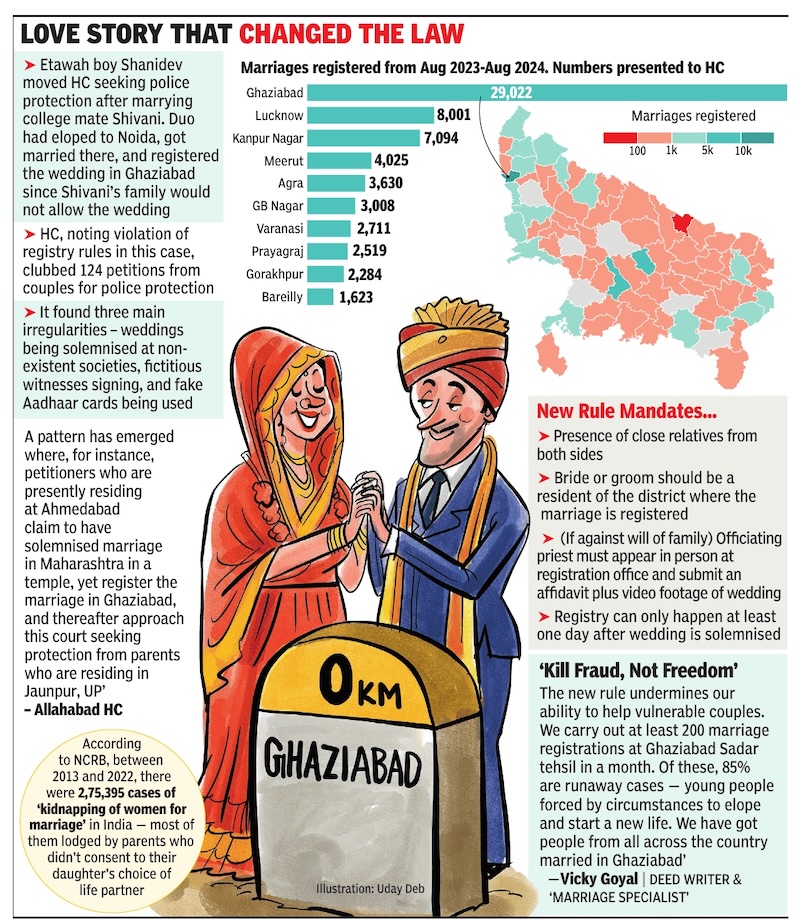
From: Ashni Dhaor, July 20, 2025: The Times of India
By the standards of the office known as ‘SRO 5’ in Ghaziabad, the second Monday of June was very slow. Only around 25 couples were in queue to register their marriage, but they waited for hours, stewing in pre-monsoon humidity, as papers went through layers of checks. Just a day after new marriage registration rules had come into effect in UP, it was far from business at usual at SRO 5, which registered 19,047 marriages in one year (Aug 2023-2024) at an average of 52 a day. For an idea of speed, this was more than six times the marriage registrations in all of Noida (3,008) and 2.5 times that of state capital Lucknow (8,001) in the same oneyear period.
Between its five SROs (subregistrar office), 29,022 marriages were registered in Ghaziabad between Aug 1, 2023 and Aug 1, 2024. But unlike ease of doing business and ease of living, ease of registering marriages earned SRO 5 and its peers no brownie points. What it did was draw the attention of Allahabad high court.
A subsequent investigation indicated Ghaziabad had become a centre for registering runaway marriages, not just from districts in UP but also Delhi, Haryana, Rajasthan, even Maharashtra. The outcome was UP govt changing registration rules for all marriages, except those under the Special Marriage Act.
After the new rules came into effect in June, among the first couples to register under them that muggy Monday afternoon was a head constable from Auraiya and the man she was marrying, a PSU clerk from Ghaziabad. As mandated by the new rules, the cop’s brother and the clerk’s father were present to attest their marriage. “I had to call my brother from Auraiya because of the new rules. I would have asked a friend, but having a close relative from both sides is compulsory now,” she said.
That day, 23 marriages were registered. There were no runaway couples among them because, besides the presence of close family, the new rules also make it mandatory for the man or woman to be a resident of the district where the marriage is registered. In cases where a marriage is against the will of the family, the officiating priest must appear in person at the registration office and submit an affidavit alongside video footage of the wedding for the registration to happen, according to the new rules, which also mandate that a marriage can’t be registered the same day it is solemnised.
The road to HC
The genesis of what would become a wide-ranging high court hearing that would see 124 petitions from couples being clubbed lay in a meeting of hearts at a govt degree college in Etawah in 2022. After a brief courtship, Shanidev, a BA student, and Shivani who was studying BSc, told their families they wanted to get married. They were from the same religion and caste, the usual grounds on which families oppose, so it shouldn’t have been a problem. But Shivani’s family would have none of it.
Faced with hostility, they decided to elope. From Etawah, their first stop was Noida. On June 3, 2024, Shivani and Shanidev submitted documents at SRO 5, stating they got married at an Arya Samaj temple in Noida. Their marriage registered, certifying them as Mrs & Mr, they approached Ranjit Yadav, an advocate in Allahabad, for help in securing police protection.
One plea opens a Pandora’s box
In July, Yadav filed a civil writ petition before the high court on the couple’s behalf, seeking directions to police to provide them protection. The petition morphed into a much bigger hearing, drawing the court’s attention to frauds and legal shortcuts being taken in registering marriages, particularly in Ghaziabad.
In its order dated May 12, referring to Shanidev’s petition, a bench of justices Anil K Sharma and Vinod Diwakar observed that the marriage certificate lacked essential information such as the name of the priest who solemnised the marriage, registered address of the Arya Samaj mandir, and names, addresses and contact details of witnesses. “These omissions raise significant concerns as to whether the marriage was performed in accordance with provisions of the Hindu Marriage Act, 1955,” the court said.
It also observed that in many cases involving runaway couples seeking police protection that landed before it, marriage certificates were issued by nonexistent societies in three places – Ghaziabad, Gautam Budh Nagar (Noida) and Prayagraj – mentioning fictitious witnesses and fake Aadhaar numbers.
“A pattern has emerged where, for instance, petitioners who are presently residing at Ahmedabad claim to have solemnised marriage in Maharashtra in a temple, yet register the marriage in Ghaziabad, and thereafter approach this court seeking protection from parents who are residing in Jaunpur, UP. The documents annexed in support of such petitions, especially proof of age and marriage, are often found to be forged. Many female petitioners have been found to be minors, ranging from 14 to 16 years of age. In several cases, it has also come to notice that the male petitioners entered into these alliances without disclosing previous marriages, relying instead on fake certificates and morphed photographs,” the court said.
How Gzb came under scanner
The subsequent court-ordered police inquiry into marriage registrations revealed Ghaziabad’s astonishingly high marriage registration numbers when compared to other districts. Shivani and Shanidev’s case was an example of how it happened. Earlier marriage registration rules mandated either the place of marriage or residence proof of the man or woman had to be in the same district as the one where the marriage was registered. Shanidev and Shivani got married in Greater Noida. Their residence was Etawah. And the marriage got registered in Ghaziabad.
“There must have been some forged documents involved in the registration process,” assistant inspector-general of Ghaziabad Pushpendra Kumar told TOI . A source at the stamps and registry office said inquiries had shown couples from many states had got their marriages registered in Ghaziabad over the years. “There were also instances of couples getting marriages registered where one of them was a foreign citizen,” a source said.
Why the rules changed
Pointing to a systemic problem, the court ruled, “Undoubtedly, every citizen, upon attaining the age of majority, has the fundamental right to choose a life partner and enter into a matrimonial alliance or livein relationship. However, this right cannot be exercised by circumventing statutory provisions or through the submission of forged and fabricated documents to the court, seeking protection under the guise of Article 21 of the Constitution. It is the collective responsibility of the state and its instrumentalities to ensure strict compliance with the law of the land and safeguard the integrity and sanctity of the institution of marriage.” On June 6, following this order, the state govt issued a notification announcing the rule change for marriage registration.
What about runaways?
But in trying to stop frauds, the new rules, lawyers and activists argue, make things very difficult for couples marrying against their families’ wishes. In May 2024, Prakash and Payal (names changed), both residents of Bulandshahr, eloped and got their marriage registered in Ghaziabad. They were in the final stages of completing formalities at deed writer Vicky Goyal’s chamber near Sadar tehsil when a Bulandshahr police team arrived. Payal’s family had filed an abduction case. “I told the police team that under the Hindu Marriage Act, two adults have the freedom to choose their life partners. We presented all valid documents like marriage certificate, Aadhaar, age proof,” Goyal said.
But as a result of the rule change, two residents of Bulandshahr cannot get married in Ghaziabad, added Goyal, who describes himself as a ‘marriage specialist’. “It undermines our ability to help vulnerable couples,” he said. “We carry out at least 200 marriage registrations at Ghaziabad Sadar tehsil in a month. Of these, 85% are runaway cases — young people forced by circumstances to elope and start a new life. We have got people from all across the country married in Ghaziabad,” Goyal said, insisting everything had been done by the book and the system needs to distinguish genuine cases from frauds.
The instant shaadi offices
Goyal is among scores of deed writers, advocates and marriage practitioners who have set up offices near Sadar tehsil with bright signboards, which advertise pictures of happily married couples with assurances like ‘Marriage Specialist Here’, ‘Arya Samaj Certificate Available’, and ‘Temple Ceremonies Arranged’.
There’s a temple right next to the Sadar tehsil where marriages can be solemnised. Some advocates have created areas behind their offices, like a small Arya Samaj mandir complete with a havan kund built in the backyard of advocate Vikas Bhadauriya’s office. A large poster proclaims “Vaidik Vivah Sanskar”. SRO 5 and 1 are closest to Sadar tehsil.
“The new rules will only promote honour killings,” said Bhadauriya. “The only reason couples flee their city is because their own families threaten them. If a marriage is registered in their home district, their family will find them.” TOI tracked down one such couple. From Rajasthan’s Bhiwadi, Mahesh and Reshma (names changed) were referred to a ‘marriage specialist’ in Ghaziabad in Feb 2024. “Our fault was that our love crossed the boundary of caste,” Mahesh said.
They two went to the local registrar’s office to get married. “But within 20 minutes, her brother was there. That is how quickly word spreads in a town. He thrashed me in public, no one came to my rescue. I was left bleeding. A local lawyer advised us to go to Ghaziabad, where all the arrangements were made. We got married at a temple, clicked photos, got a certificate from the priest, and then went straight to the registrar’s office,” he added.
Stop frauds, but help couples
Social activists agreed the new rules will make registering marriages for inter-caste couples. Harsh Malhotra from Love Commandos, a Delhi-based NGO that provides refuge to runaway couples, told TOI , “The home district rule is not practical for couples. This policy will undermine the freedom of marriage. It will empower families who disapprove of the marriage to track their children and separate or harm them.” But forged documentation and fraud must stop, he added. “Ghaziabad has gained a bad reputation when it comes to marriage registrations because of reports of forged documents being used. We hope agents will stop defrauding couples who trust strangers.”
Pollution: air
Ghaziabad raises a stink
Neha Lalchandani | TNN
Its proximity to the Capital might have actually caused more damage to Ghaziabad than good. While it was busy dealing with its own pollution mess, a large part of Delhi’s unorganized small-scale waste recycling units shifted base there after Delhi government’s drive against defaulters. Result: Ghaziabad is not just one of the two most polluted cities in UP but also among the most polluted in India.
The city’s air pollution levels have violated most parameters. The biggest problem is particulate matter that is several times more than the desired level of 60 micrograms per cubic metre. The Sahibabad Industrial area and Bulandshahr Industrial areas recorded an average particulate matter levels of 243.2 microgram/cum and 239.1 microgram/cum respectively in 2009. Large-scale development work, Metro construction and heavy vehicular traffic have only worsened the situation.
Officials point out that rapid development in the city violated all land use norms with many residential complexes mushrooming around industrial areas. “The city spread really fast and industries that were earlier away from the main city have now become the centre of residential clusters. We are trying to now provide CNG or liquid gas to industries that are coal based,’’ said a UP pollution control board official.
The area is known for its dyeing plants, electroplating units, paper plants and waste and scrap plastic recycling sectors, many of which dump their waste just about anywhere they please. Officials say that about 300 such units have been shut down but since there are no records of the extent of activity, it is very difficult to crack down on them.
Ghaziabad’s Hindon river is now choking with the city’s filth. The city has two sewage treatment plants with a capacity of 129 million litres per day to treat its 160 mld sewage. Three STPs are being set up and another two have been proposed.
Why the air is so bad
Abhijay Jha, Nov 1, 2019: The Times of India
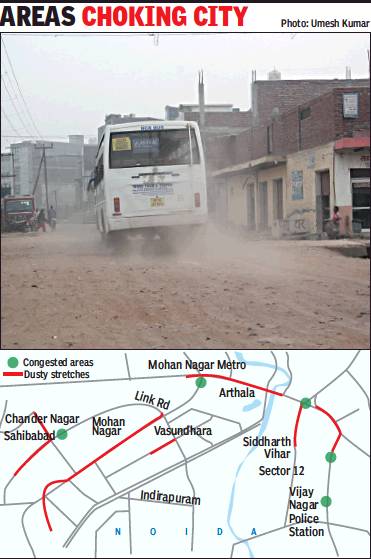
From: Abhijay Jha, Nov 1, 2019: The Times of India
Dust that won’t disperse and traffic congestions that don’t ease — the Central Pollution Control Board (CPCB) has identified these as the factors exacerbating air pollution in Ghaziabad, one of the most polluted cities in the country at the moment.
“We identified over 20 areas in the city where dust pollution is the most severe. Different agencies and departments have been asked to carry out water sprinkling since the Graded Response Action Plan kicked in. The Ghaziabad Municipal Corporation is responsible for water sprinkling along a 90-km stretch within the city’s municipal limits and for mechanized sweeping along another 106-km stretch,” a district official said.
On paper, regular water sprinkling is being done on several such stretches — Mohan Nagar to GT Road, Sahibabad to Maharajpur, Sahibabad to Chandra Vihar, Meerut Road to Dudheshwarnath Temple, Vasundhara to Prahladgarhi and Dabur Chowk to UP Gate, among others — to control dust pollution.
On the ground, it does not show. Unpaved stretches – in Nandgram, Loni’s Rashid Nagar, Bhatta Number 5 Road in Sikroad, Vijay Nagar bypass and Siddharth Vihar — remain clouded in dust all through the day.
The official explanation was that these roads are “interior” ones. “These stretches are sources of dust pollution, but are internal roads within colonies. We have taken care of the main roads, which are in good shape,” the district official said.
Then there are areas – in Indirapuram and Shastri Nagar – with no green paving, which doesn’t help control dust either. Ghaziabad Development Authority (GDA) vice-chairperson Kanchan Verma offered a defence: “Green paving has been done across most of the city, but there are many pavements we are yet to cover. The immediate problem that we face is that of encroachment by street vendors. Evicting them from the roads is a major challenge, because of which we have not been able to complete green paving on many stretches.”
For now, the Authority has identified sections it plans to develop as “model roads”. “We have selected 10 spots where these model roads will have green paving. But work on it will be finished only by next year,” Verma added.
For traffic congestion, the other big contributor to Ghaziabad’s pollution, the GDA has brought the Central Road Research Institute (CRRI) on board to prepare a traffic mobility plan.
“The CRRI has pointed out 14 major intersections with the highest traffic congestion — the most prominent being GDA Old Bus Stand, Choudhary Mor, Indirapuram SRS Cinemas and Kanawani Intersection. The CRRI has also recommended changes in road design in some places. We have implemented the recommendations in Indirapuram and will do so in other parts of the city soon,” Verma said.
Roads/ communications
Flyover from UP Gate to Raj Nagar Extn
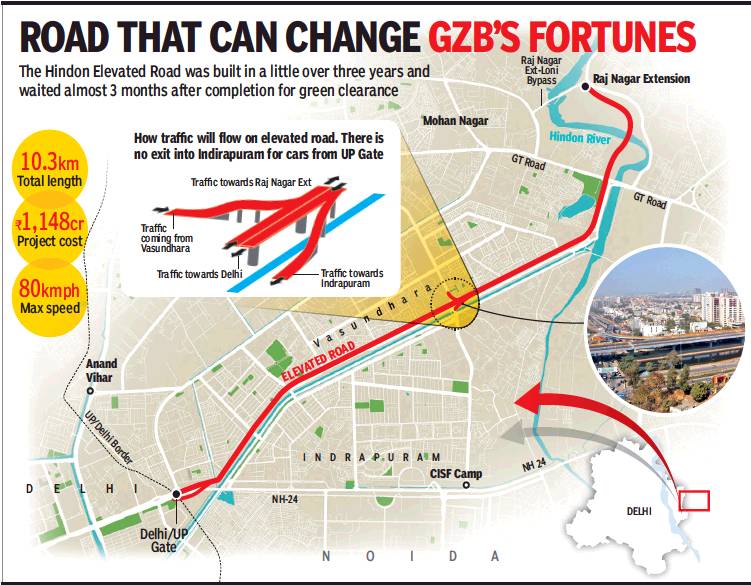
From: Aditya Dev, Abhijay Jha & Ayaskant Das , 10.3km flyover will take you from UP Gate to Raj Nagar Extn in 9 minutes, March 31, 2018: The Times of India
FASTER DELHI RIDE: UP CM Yogi Inaugurates Six-Lane Elevated Road Over Hindon
NCR’s longest flyover, a 10.3km, six-lane elevated road that connects Raj Nagar Extension in Ghaziabad with NH-24 at the Delhi border, opened to traffic on Friday morning, nearly three months after it was completed but had to wait for environmental clearance.
The road is the secondlongest in the country to be built on viaducts — after the Kanpur bypass on NH-2 (23km, approximately) — and reduces the journey time between UP Gate and Raj Nagar Extension to just 10 minutes from 45-60 minutes that it normally took in peak traffic before the road opened. The rod has a speed limit of 80kmph.
It also greatly benefits those headed for Meerut, Haridwar and Dehradun by allowing them to bypass busy Ghaziabad traffic. Since it has been integrated with NH-24, whose widening up to UP Gate is almost complete, it basically gives Delhi-Ghaziabad traffic a signalfree ride between Sarai Kale Khan and Raj Nagar Extension, a distance of 25km that can now be covered in half an hour or less, depending on traffic.
However, the flip side is that the road cannot service traffic headed for Indirapuram and Vasundhara from Delhi. That’s because the ramp on the UP Gate-Raj Nagar Extension carriageway is only meant for incoming cars headed in the direction of Raj Nagar Extension.
The ramp cannot be used for exit. The ramp on the opposite side can, however, be used for exit but only by cars coming from Raj Nagar Extension that want to enter Indirapuram.
The flyover, called Hindon Elevated Road, or elevated road, which runs along Indirapuram’s Hindon canal, was inaugurated at 11.15am on Friday by chief minister Yogi Adityanath, almost three and a half years after construction started in 2014 when the state was under Akhilesh Yadav’s rule. Eager to take credit for it, a group of Samajwadi Party workers had even done an “inauguration” of the bridge earlier in March.
The CM and his entourage, as well as senior BJP functionaries that included Ghaziabad MP and former Army chief V K Singh, were the first commuters on the road as they took a 3km ride before proceeding to the Ramlila ground in Kavi Nagar to address a public rally. After that, the road was thrown open to traffic from the Raj Nagar Extension side.
Kuldeep Ahlawat, an associate manager (IT) with Perfetti Van Melle in Gurgaon and one of the first commuters, said, “The biggest benefit will be that commuters will now be able to save 30-40 minutes of their journey to Delhi. We will also save on fuel which is wasted waiting at several traffic signals otherwise.”
The road has the potential to change Ghaziabad’s fortunes and lift the status of its real estate, both in trans-Hindon townships like Vasundhara and Indirapuram as well as Mohan Nagar and Raj Nagar that have always been in the shadows of Noida. With the Red line extension of Delhi Metro, via Mohan Nagar up to New Bus Stand, also nearing completion, residents of these areas will see a quantum improvement in connectivity with Delhi and the rest of NCR.
But there was also concern about possible bottlenecks that traffic headed towards Raj Nagar Extension would face. Sarvendra Kumar, delivery head with Salm Solution, said, “We have been waiting for the opening of this road for a long time. It will help us reach Delhi in the shortest possible time during peak hours. But Raj Nagar Extension will face a huge traffic inflow from nearby areas.”
Pramod Dhankar, general secretary, RWA federation (Ghaziabad), said, “The Raj Nagar Extension crossing will face a massive jam due to traffic from Meerut and Modinagar from one side and Raj Nagar, Kavi Nagar and Govindpuram on the other side. A few alternative roads were planned by the civic bodies, but are yet to be commissioned. Let’s see how police and civic bodies deal will this issue.”
A TOI team also travelled on the flyover from Raj Nagar Extension to UP Gate and back on Friday afternoon. It took us nine minutes one-way at a speed of 80 kmph. However, there at least three possible traffic bottlenecks that will worry Ghaziabad police — at the entry point to the flyover in Raj Nagar Extension, the exit to NH-24 underneath UP Gate flyover and at the foot of the mid-point exit ramp at Kanawani (Mohan Nagar Link Road) in Indirapuram.
There was a jam at the Raj Nagar Extension entry at the newly installed traffic signal in the absence of monitoring by cops. Vehicles travelling in the opposite directions from Raj Nagar Extension and from GT Road side merged into each other at the rotary. The U-turn that the GDA is constructing near the Raj Nagar Extension rotary will take about three months to complete and the traffic signal installed as a stop-gap arrangement will be done away with. The signal, however, needs to be manned by traffic cops, especially during peak hours, because of a tendency to break rules.
At the Kanawani exit ramp in Indirapuram, descending traffic will run straight into vehicles on the Hindon canal road. Police have planned to make this stretch one-way.
Near the UP Gate exit, vehicles taking a U-turn below the UP Gate flyover or travelling towards Kaushambi are merging with each other in opposite directions.
Hyderabad-based Navyuga Engineering Company, which built the road, has its maintenance for the next five years after which it will be handed over to the GDA. Of its total length of 10.3km, 9.3km is elevated. There are 3,497 conjoined segments supported by 287 single pillars or piers with an average height of about 10 metres.
The pillars are concrete structures buried about 32 feet into the ground.
Built at a cost of Rs 1,147 crore, it is expected to see a traffic load of about 4,000 vehicles per hour during peak hours. A patrolling team will carry out round the clock survey of the road and, in addition, will also provide 24-hour ambulance services with paramedical staff to attend to any accident victims on the stretch. Heavy vehicles are barred from entering the elevated road as of now.
